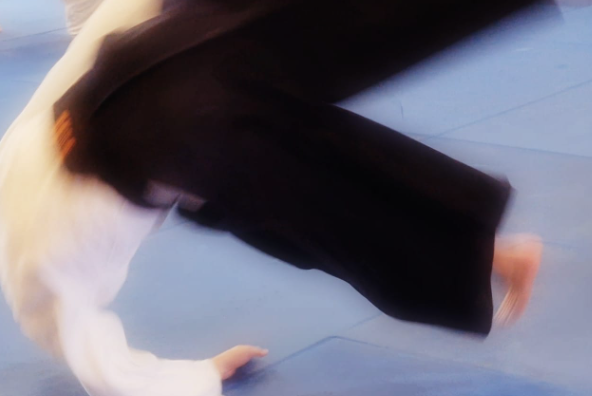In some martial disciplines, such as Aikido, Judo, and Ju Jutsu, it is essential to learn how to absorb a technique by falling.
Accessible to Everyone
The teaching of ukemi (受け身) plays a crucial role for practitioners of all ages. In fact, a significant part of an adult’s decision to continue or quit training depends on how they are guided through such movements -and how they experience them.
This is why a gradual approach, a solid teaching methodology, and some useful tools -such as gymnastics mats and fitballs -are essential. Some people find it natural to let go, making their bodies round and flexible enough to roll on the tatami. For others, it is not as easy.
In the past, some instructors used to say, “Aikido is for everyone, but not everyone is for Aikido.”
We believe that everyone can experience Aikido in its fundamental aspects -though at different levels of performance, depending on the unique combination of subjective and objective factors that shape each individual’s practice.
The projection, or tobi ukemi (飛び受け身), is one of the experiences accessible to everyone. If introduced responsibly, it can leave a profound impact on the practitioner, generally leading to greater engagement in training and a more conscious approach to the discipline. Let’s explore why.
Dissipation
From a biomechanical perspective, a projection is a form of ukemi where one degree of freedom is removed.
If, as a result of a push, an imbalance, or the application of a joint lock, uke is free to detach from nage, their body dissipates energy by falling and rising back up.
However, when speed increases, when a technique is applied suddenly, or when uke is held (often by an arm), the ukemi becomes more explosive. In this case, uke’s body does not dissipate energy by falling centrifugally away from tori, but rather remains in place.
Sometimes, the projection happens by uke’s own choice, as they grip onto a contact point on their partner. Other times -especially in weapons practice– they hold onto the sword or jo when it is being taken away during a disarming or projection technique.
In Detail
What happens in the psychophysical system of the person being projected?
The state of alertness ensures that attention remains engaged throughout the entire action. This state, often described as flow, leads to an altered perception of time and space.
In other words, it mirrors the well-known anecdote -wrongly attributed to Einstein -to explain relativity:
“When a man sits for an hour with a beautiful woman, it seems like a minute. But let him sit on a hot stove for a minute, and it will seem longer than any hour”.
The adrenaline rush that comes from being flipped over (where one goes from an upright position to the ground in a split second while rotating around a point) triggers primal danger responses, which are immediately counteracted by the realization that the landing surface –the tatami– is decently soft. (Oftentimes).
This momentary contradiction overloads our system, contributing to the sensation of space-time dilation.
At the same time, the vestibular system, responsible for balance, struggles to process the conflicting signals coming from the postural system, further enhancing the sense of time expansion.
The circular nature of the movement, combined with the increased focus in a fluid and relaxed practice, amplifies the effects of tobi ukemi.
The result? When well-trained, a projection offers a unique sensory experience -one that makes it feel as if time is slowing down and the body has virtually no physical limitations.
What Is It For?
How can we use projections?
From our perspective, a projection is a vision activator. Let us say more about that.
In the progression of any discipline, there are key moments that mark a deeper understanding of what the discipline itself can offer.
Mastery of a technique, passing a test, the ability to surrender to a fall while remaining actively engaged -all these things enhance our depth of vision.
This is not just about positive reinforcement (though that is important –“I did it!”). More significantly, the experience of space-time dilation reveals just how transformative it is to fully live in the present moment.
If every moment matters, then the discipline itself can become a tool for refining our vision of who we want to be –today, for tomorrow.
The “Wow” Effect
For this reason, while recognizing the technical importance of projections -both as a mean to prevent injuries when training with an unfamiliar partner and as a survival skill (for example, when slipping on the street) -we see tobi ukemi as something rare and precious, like an exotic spice.
If we season our practice with too many projections, we risk becoming desensitized. That tear in the space-time continuum begins to close, losing its magic.
At the same time, if we never include projections, our practice might feel monotonous, like eating the same familiar dish over and over again. More importantly, we would be missing out on an irreplaceable, unique experience.
During demonstrations, projecting a partner often makes the audience go: “Ooooooh!” And that’s fine –it’s marketing.
But in practice, we should strive for fewer “Ooooooh!” and more “Wow”. The former can be staged; the latter is spontaneous.
This is why a solid teaching method for falls and projections is essential -to guide each individual to the threshold of amazement and allow them to step through on their own, without force.

